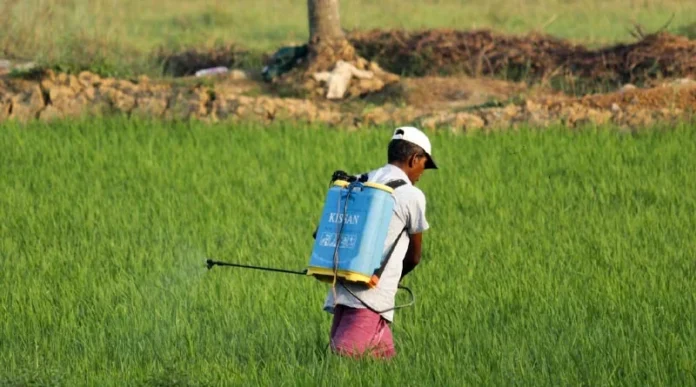New Delhi: A comprehensive study conducted between October 2021 and April 2023 has uncovered alarming details about the impact of pesticide exposure on agricultural communities in Telangana, India. The research was sponsored by a collaboration between the Indian Council of Medical Research (ICMR) and the Department of Science and Technology (DST), Government of India. This in-depth investigation, which covered 15 villages across three districts—Yadadri-Bhuvanagiri, Vikarabad, and Sangareddy—offers new insights into the health risks posed by long-term pesticide use. It highlights the urgent need for action to protect farmers from the harmful effects of these chemicals.
The Scope of the Study
The study was initiated to assess the level of pesticide exposure among farmers and agricultural workers, a group frequently exposed to hazardous chemicals due to their close proximity to crop protection products. Researchers from various institutions collaborated, conducting extensive fieldwork across 493 participants, who were divided into two groups: those exposed to pesticides and a control group with no known exposure.
The villages were randomly selected, with five from each district, to ensure a broad representation of Telangana’s agricultural regions. The survey method involved in-depth interviews, medical examinations, and the collection of blood and urine samples from the participants.
Pesticide Detection: Advanced Analytical Techniques
One of the standout aspects of the study was the use of cutting-edge technology to detect pesticide residues in urine samples. The analysis employed Liquid Chromatography-Mass Spectrometry/Mass Spectrometry (LC-MS/MS) technology to detect 28 commonly used pesticides, including organophosphates, carbamates, pyrethroids, and neonicotinoids.
The results were sobering. Participants in the exposed group showed significantly higher concentrations of pesticides in both blood and urine samples compared to those in the control group. The detected levels were often far above the permissible limits set by international health standards, indicating prolonged and unsafe exposure.
Health Impacts: A Growing Concern
The study’s findings highlight the severe health consequences of pesticide exposure. Farmers and agricultural workers who were exposed reported a wide range of symptoms, including shortness of breath, dizziness, headaches, nausea, and muscle weakness. Many of these symptoms are linked to chronic exposure to organophosphates, one of the most dangerous classes of pesticides used in India.
Organophosphates inhibit the enzyme acetylcholinesterase, which is critical for nerve function. Over time, exposure to these chemicals can lead to neurological disorders, respiratory issues, and even death. Several participants exhibited symptoms of neurotoxicity, and there were concerning reports of increased cancer rates in regions where pesticide use is prevalent.
Additionally, chronic pesticide exposure is associated with long-term health conditions, such as liver and kidney damage, hormonal imbalances, reproductive disorders, and respiratory diseases. This research underscores the dire need for immediate intervention to prevent further harm to these vulnerable communities.
The Lack of Safety Measures
One of the most concerning revelations from the study is the inadequate safety measures followed by farmers in Telangana. The survey found that the vast majority of farmers either did not use personal protective equipment (PPE) or used it inconsistently. Many farmers were unaware of the risks posed by handling pesticides without proper protection.
Even when farmers were informed of the dangers, economic constraints often prevented them from purchasing PPE such as gloves, masks, and goggles. This gap in knowledge and access to safety equipment exacerbates the risk of pesticide exposure and its associated health problems.
Policy Implications: The Need for Regulation and Education
The findings of this study bring into sharp focus the need for better regulations and policies to safeguard the health of agricultural workers. While the government has taken steps to regulate the sale and use of highly toxic pesticides, enforcement remains weak, particularly in rural areas where oversight is limited.
Stricter enforcement of existing pesticide regulations is needed to ensure that dangerous chemicals are not misused. This includes more rigorous checks on the sale of unregistered or banned pesticides, as well as measures to ensure that farmers are educated about the risks of pesticide exposure.
Educational programs that focus on safe pesticide use are essential. Farmers must be trained in proper pesticide handling techniques, including how to apply chemicals safely and the importance of using PPE. Public health campaigns should be launched to raise awareness about the dangers of exposure, particularly in communities where literacy rates are low, and information may be hard to access.
Alternatives to Pesticides: A Path to Sustainability
The study also raises important questions about the sustainability of current farming practices in Telangana and other parts of India. The reliance on chemical pesticides to boost crop yields has created a toxic environment for both farmers and the ecosystem. There is a growing movement advocating for the adoption of Integrated Pest Management (IPM) practices, which aim to reduce the use of chemical pesticides by promoting alternative methods such as biological controls, crop rotation, and the use of resistant crop varieties.
IPM programs, when combined with organic farming techniques, have shown promising results in reducing pesticide use while maintaining or even increasing crop productivity. The transition to sustainable farming practices is not only necessary for protecting farmers’ health but also for preserving soil and water quality in the long term.
The Road Ahead: Addressing the Crisis
The Telangana study paints a stark picture of the dangers facing India’s agricultural workers. With pesticide exposure linked to a wide range of health problems, it is crucial that both the government and the agricultural industry take immediate steps to address this issue.
Implementing stricter safety protocols, educating farmers about pesticide risks, and promoting alternative farming practices are all essential steps in safeguarding the health and well-being of those who feed the nation. It is not enough to focus solely on productivity—protecting the health of farmers must become a priority in the drive toward agricultural development.
As more studies like this come to light, the pressure will grow for policymakers and industry leaders to act. The findings from Telangana should serve as a wake-up call to rethink how we approach farming in India, prioritizing the health of agricultural workers and the sustainability of our ecosystems over short-term gains in crop production.
The 28 Pesticides
The following 28 commonly used pesticides were identified in the study, spanning various classes such as organophosphates, carbamates, pyrethroids, and neonicotinoids:
1. Atrazine (Herbicide)
2. Chlorpyrifos (Organophosphate)
3. Malathion (Organophosphate)
4. Monocrotophos (Organophosphate)
5. Dimethoate (Organophosphate)
6. Phorate (Organophosphate)
7. Parathion (Organophosphate)
8. Acephate (Organophosphate)
9. Carbaryl (Carbamate)
10. Methomyl (Carbamate)
11. Aldicarb (Carbamate)
12. Carbosulfan (Carbamate)
13. Fenobucarb (Carbamate)
14. Cypermethrin (Pyrethroid)
15. Lambda-cyhalothrin (Pyrethroid)
16. Deltamethrin (Pyrethroid)
17. Fenvalerate (Pyrethroid)
18. Bifenthrin (Pyrethroid)
19. Imidacloprid (Neonicotinoid)
20. Thiamethoxam (Neonicotinoid)
21. Acetamiprid (Neonicotinoid)
22. Clothianidin (Neonicotinoid)
23. Fipronil (Phenylpyrazole)
24. Endosulfan (Organochlorine)
25. Dichlorvos (Organophosphate)
26. Diazinon (Organophosphate)
27. Quinalphos (Organophosphate)
28. Glyphosate (Herbicide)


